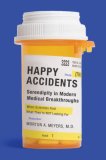Summary | Excerpt | Reviews | Beyond the Book | Readalikes | Genres & Themes | Author Bio

Critics' Opinion:
Readers' Opinion:
First Published:
Mar 2007, 408 pages
Paperback:
Dec 2008, 408 pages
 Book Reviewed by:
Book Reviewed by:
BookBrowse Review Team
Buy This Book
The Normal versus the Revolutionary
In his highly influential 1962 book The Structure of Scientific Revolutions,
Thomas Kuhn contributed an idea that changed how we see the
history of science.6 Kuhn makes a distinction between “normal” and
“revolutionary” science. In “normal” science, investigators work within
current paradigms and apply accumulated knowledge to clearly defined
problems. Guided by conventional wisdom, they tackle problems
within the boundaries of the established framework of beliefs
and approaches. They attempt to fit things into a pattern. This approach
occupies virtually all working researchers. Such efforts, according
to Nobel laureate Howard Florey, “add small points to what
will eventually become a splendid picture much in the same way that
the Pointillistes built up their extremely beautiful canvasses.”
Kuhn portrays such scientists as intolerant of dissenters and preoccupied
with what he dismissively refers to as puzzle-solving. Nonetheless,
a period of normal science is an essential phase of scientific
progress. However, it is “revolutionary” science that brings creative
leaps. Minds break with the conventional to see the world anew. How
is this accomplished? The surprising answer may be “blindly”! Systematic
research and happenstance are not mutually exclusive; rather
they complement each other. Each leads nowhere without the other.
According to this view, chance is to scientific discovery as blind
genetic mutation and natural selection are to biological evolution. The
appearance of a variation is due not to some insight or foresight but
rather to happenstance. In groping blindly for the “truth,” scientists
sometimes accidentally stumble upon an understanding that is ultimately
selected to survive in preference to an older, poorer one.
As explained by Israeli philosophers of science Aharon Kantorovich
and Yuval Ne’eman, “Blind discovery is a necessary condition
for the scientific revolution; since the scientist is in general ‘imprisoned’
within the prevailing paradigm or world picture, he would not
intentionally try to go beyond the boundaries of what is considered
true or plausible. And even if he is aware of the limitations of the scientific
world picture and desires to transcend it, he does not have a
clue how to do it.”
Excerpted from Happy Accidents by Morton Meyers, M.D. Copyright © 2007 by Morton Meyers, M.D. Excerpted by permission of Arcade Publishing. All rights reserved. No part of this excerpt may be reproduced or reprinted without permission in writing from the publisher.





The House on Biscayne Bay
by Chanel Cleeton
As death stalks a gothic mansion in Miami, the lives of two women intertwine as the past and present collide.

The Flower Sisters
by Michelle Collins Anderson
From the new Fannie Flagg of the Ozarks, a richly-woven story of family, forgiveness, and reinvention.

The Funeral Cryer by Wenyan Lu
Debut novelist Wenyan Lu brings us this witty yet profound story about one woman's midlife reawakening in contemporary rural China.
Your guide toexceptional books
BookBrowse seeks out and recommends the best in contemporary fiction and nonfiction—books that not only engage and entertain but also deepen our understanding of ourselves and the world around us.